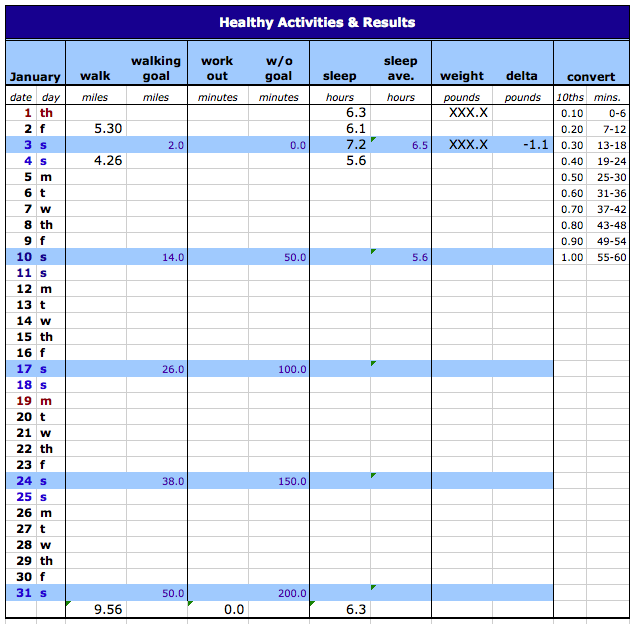Like everyone I know, I have limited time for keeping track of progress toward my health and fitness goals. Still, keeping track is important.

- Why? We know that tracking progress makes a huge difference. For example, after I set specific walking goals and then regularly checked to see how I was doing, I walked twice as far as before.
- But the Problem… If the system for completing a daily or weekly review is too time-consuming or cumbersome, then it’s difficult to keep using it. For example, last year, I gradually increased my average sleeping time 7.5 hours per night. But then I stopped keeping track, and I slid back into the land of not enough sleep.
And now, in one focus area after the other, I’m tracking activities and progress in ways that are motivating, but also quick and simple. In the case of healthy activities and results, I’ve created a spreadsheet to help keep track and stay motivated.

Activities & Goals. Here are the keep-me-healthy activities I’ve decided to track for this year (and your activities and goals would vary):
- Walk 50 miles a month
- Work out 50 minutes a week
- Sleep an average of 7 hours a night
- Lose 3 pounds a month (to my goal weight)
On the spreadsheet, each activity has two columns: one for the activity, and the other for the goal. The measures are all different: miles, minutes, hours, and pounds. The columns labeled “convert” are there to make it easy to change minutes into tenths of hours.
This spreadsheet is just an example, and you could replace everything on it with your own set of healthy activity goals (running, biking, dancing, calories). But here are some details about the activities on this chart, just as a “for instance”:
- Walking. For walking, miles walked go in the left column. The goal miles listed in the right column, on Saturdays, are a guide to help stay on track. If, for example, on January 17th I’ve only walked 20 miles, then I have some catching up to do. I use Charity Miles and Nike+ Running to track walking miles.
- Working Out. I have an appointment once a week to spend 50 minutes in the gym. In this example, the left column is for recording time actually working out, and the right column shows the goal minutes at 50 per week.
- Sleeping. Last year, I gradually increased my average sleeping goal from 6.0 hours to 7.5. But then I stopped keeping track, and I slid back into the land of not enough sleep. I’m going back now to tracking more carefully. I use Sleep Cycle to record sleeping and waking times.
- Weight. If you are trying to lose or maintain your weight, it can be helpful to weigh yourself often. Like all things related to diet, nutrition, and weight loss, you can find just about any point of view from different sources. But, if you don’t have an eating disorder, and you realize that everyone’s weight fluctuates, then weighing yourself every day, or at least once a week, helps most people.
- Saturdays. The entries for Saturday are shaded, because that’s the day I plan to do my weekly reviews. Some people like to do them on Sundays or even Wednesdays (to give a boost to the middle of the week).
If you want a quick-and-easy way to track your activities, feel free to modify these ideas. There’s a link in the Resources below to the spreadsheet, or you can make your own or even track your activities on paper. Tracking can make the difference between reaching your goals, or not.
Resources
Post | Specific Goals? On the Calendar? I’m a Believer Now
Spreadsheet | Healthy Activities & Benefits
iOS App | Charity Miles
iOS App | Nike+ Running App
iOS App |Sleep Cycle App
